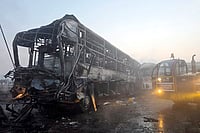The second in a series of relentless atmospheric rivers slammed into California early Monday, exacerbating the state's existing weather woes with heavy rains, flooding, and hurricane-force winds. As the state grapples with the aftermath of the first atmospheric river, which struck last week, emergency services and residents faced a daunting new challenge.
The storm wreaked havoc across the San Francisco Bay Area on Sunday, inundating streets, toppling trees, and bringing down power lines with winds reaching over 60 mph (96 kph) in some areas. The mountains experienced gusts exceeding a staggering 80 mph (128 kph). In San Jose, emergency crews rescued individuals stranded in floodwaters, emphasizing the perilous conditions gripping the region.
The storm's impact prompted school closures across Santa Barbara County, still reeling from the devastating mudslides of 2018 caused by powerful storms. Southern California faced treacherous conditions, with flooding reported in Ventura, leaving residents like Alexis Herrera struggling to navigate submerged freeways.
Power outages plagued the state, with more than 845,000 customers without electricity by Sunday evening, according to poweroutage.us. San Francisco International Airport experienced hours-long delays, affecting 155 departing flights and leading to 69 cancellations.
The Pineapple Express storm, named for its plume of moisture stretching from the Pacific to near Hawaii, brought a rare "hurricane-force wind warning" to the Central Coast. Wind gusts of up to 92 mph (148 kph) were forecasted from the Monterey Peninsula to the northern section of San Luis Obispo County.
Meteorologist Ryan Kittell of the National Weather Service's Los Angeles-area office highlighted the slow-moving nature of the storm, increasing the risk of flooding. Evacuation orders and warnings were issued for mountain and canyon areas in Monterey, Santa Barbara, Ventura, and Los Angeles counties.
Governor Gavin Newsom declared a state of emergency for several counties, activating the Governor's Office of Emergency Services to position personnel and equipment strategically. Evacuation orders were in effect, particularly in wildfire burn areas, with shelters set up for displaced residents.
The storm, anticipated to move down the coast, is expected to bring heavy rain, flash-flooding, and mountain snow to the Los Angeles area late Sunday. The Los Angeles Unified School District, the second-largest in the nation, planned to open schools as usual Monday, with a reevaluation scheduled for 6 a.m.
The National Weather Service forecasted up to 8 inches (20 cm) of rainfall across Southern California's coastal and valley areas, with a possibility of 14 inches (35 cm) in the foothills and mountains. Heavy to moderate rain is expected in Southern California until Tuesday, prolonging the state's struggle against severe weather conditions.


























